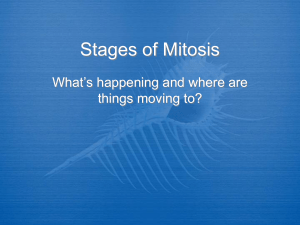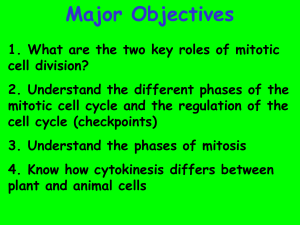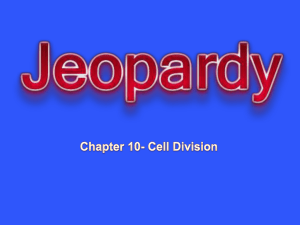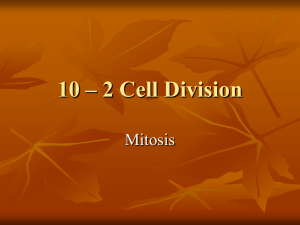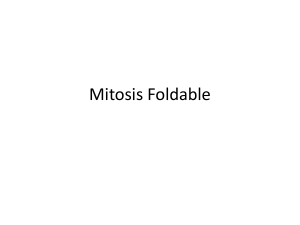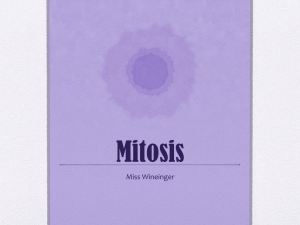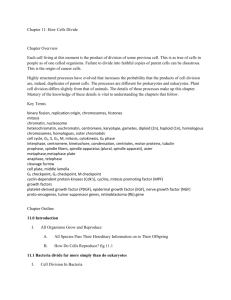Chapter 8 Part A – Cellular Reproduction Objectives
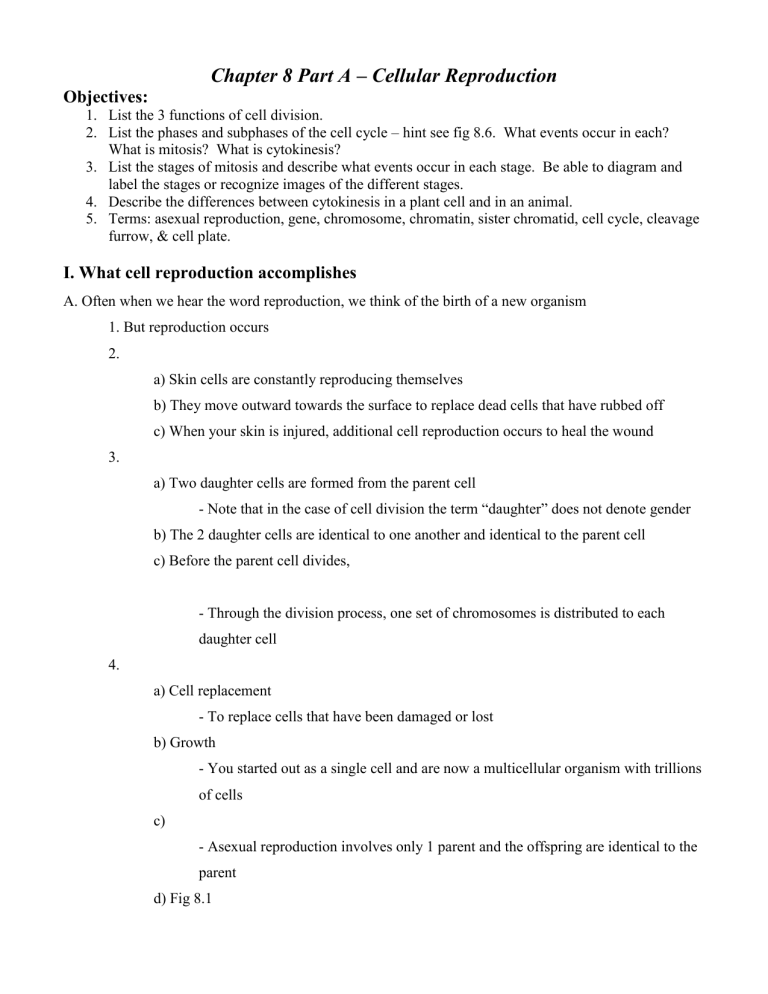
Chapter 8 Part A – Cellular Reproduction
Objectives:
1.
List the 3 functions of cell division.
2.
List the phases and subphases of the cell cycle – hint see fig 8.6. What events occur in each?
What is mitosis? What is cytokinesis?
3.
List the stages of mitosis and describe what events occur in each stage. Be able to diagram and label the stages or recognize images of the different stages.
4.
Describe the differences between cytokinesis in a plant cell and in an animal.
5.
Terms: asexual reproduction, gene, chromosome, chromatin, sister chromatid, cell cycle, cleavage furrow, & cell plate.
I. What cell reproduction accomplishes
4.
A. Often when we hear the word reproduction, we think of the birth of a new organism
1. But reproduction occurs
2. a) Skin cells are constantly reproducing themselves b) They move outward towards the surface to replace dead cells that have rubbed off c) When your skin is injured, additional cell reproduction occurs to heal the wound
3. a) Two daughter cells are formed from the parent cell
- Note that in the case of cell division the term “daughter” does not denote gender b) The 2 daughter cells are identical to one another and identical to the parent cell c) Before the parent cell divides,
- Through the division process, one set of chromosomes is distributed to each daughter cell a) Cell replacement
- To replace cells that have been damaged or lost b) Growth
- You started out as a single cell and are now a multicellular organism with trillions c) of cells
- Asexual reproduction involves only 1 parent and the offspring are identical to the parent d) Fig 8.1
II. The Cell Cycle
B.
A. Genes are located on chromosomes within the nucleus
1. Terms: a) Gene: A segment of DNA that contains the instructions to build 1 protein b) Chromosome:
- All normal members of the same species have the same number of chromosomes
- Fig 8.2 c) Chromatin: Chromosomes are made up a material called chromatin
-
- Most of the time, the chromosomes exist in a mass of chromatin fibers
- As a cell prepares to divide, the chromatin condenses
- During division, the chromosomes are clearly visible using a light microscope
- Fig 8.3
2. Before division, the cell duplicates all of its chromosomes a) After replication, each chromosome now consists of 2 copies called sister chromatids
- Each sister chromatid contains identical genes
- The sister chromatids are joined at a central region called the centromere
- Fig 8.4 b) When a cell divides, the sister chromatids are separated so that each daughter cell gets 1
- Once the sister chromatids are separated,
- Fig 8.5
1. The rate at which a cell divides depends on its type and role within an organism a) Some dividing everyday, others much less often, some not at all
2. The time and events that occur from the time a cell forms until it divides itself is called the cell cycle a) The cell cycle switches
3. a) Interphase consists of 3 subphases
- The G1 phase (“first gap”) centered on growth
- The S phase (“synthesis”) when the chromosomes are copied
- The G2 phase (“second gap”) where the cell completes preparations for cell division
- During all subphases, the cell grows and produces proteins and organelles
4. The mitotic phase (M phase) a) Mitosis is the steps that divide the nuclear material b) Cytokinesis is the division of the cytoplasm of the cell
5. The end result of the cell cycle is the production of two daughter cells that have identical nuclei, organelles, and cytoplasm
6. Fig 8.6
C. Stages of Mitosis
1. a) Chromosomes condense and coil so that they can be viewed as individual chromosomes b) The mitotic spindle begins to form microtubules grow out from centrosomes c) The nuclear membrane begins to break down
2. a) The Nuclear membrane breaks up completely – the phospholipids are stored in vesicles b) Microtubules form spindle fibers = form Spindle Apparatus c) Spindle Apparatus pull chromatids to the cell’s equator (metaphase plate) d) Sister chromatids now orient towards opposite poles
3. a) The 2 sister chromatids separate – pulled by the microtubule they are linked to b) They are now called chromosomes
c) Every chromosome in the parent now has 1 daughter chromosome at each pole d) The cell elongates
4. a) Chromosomes un condense & go back to their thread-like form (chromatin)
& the spindle apparatus breaks down b) Nuclear envelopes form around the two separate groups of chromosomes
5. Fig 8.7
6. Cytokinesis a) Begins in late anaphase b)
- A depression forms at the cell equator called a cleavage furrow
- Think of it like a belt tightening around a waist
- Actin microfilaments pull cell membranes together & cut the cell in half
- Forms 2 identical daughter cells c)
- Different due to the cell wall
- Vesicles (filled with cellulose) accumulate at the cell equator
- Vesicles fuse together forming a cell plate – cell plate forms from the middle towards the parent cell membrane & cell wall
- The newly formed cell membrane & cell wall fuse the parent’s
- Forms 2 identical daughter cells
d) Fig 8.8
7. Mitosis/Cytokinesis videos a) Mitosis by ppornelubio b) Mitosis Demonstration by maureensullivan



